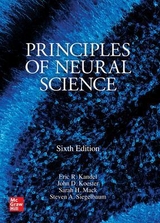
Principles of Neural Science
McGraw-Hill Medical (Verlag)
978-0-07-139011-8 (ISBN)
- Titel ist leider vergriffen;
keine Neuauflage - Artikel merken
Publisher's Note: Products purchased from Third Party sellers are not guaranteed by the publisher for quality, authenticity, or access to any online entitlements included with the product.
Now updated: the definitive neuroscience resource-from Eric R. Kandel, MD (winner of the Nobel Prize in 2000); James H. Schwartz, MD, PhD; Thomas M. Jessell, PhD; Steven A. Siegelbaum, PhD; and A. J. Hudspeth, PhD
A Doody's Core Title for 2020!
900 full-color illustrations
Deciphering the link between the human brain and behavior has always been one of the most intriguing-and often challenging-aspects of scientific endeavor. The sequencing of the human genome, and advances in molecular biology, have illuminated the pathogenesis of many neurological diseases and have propelled our knowledge of how the brain controls behavior.
To grasp the wider implications of these developments and gain a fundamental understanding of this dynamic, fast-moving field, Principles of Neuroscience stands alone as the most authoritative and indispensible resource of its kind.
In this classic text, prominent researchers in the field expertly survey the entire spectrum of neural science, giving an up-to-date, unparalleled view of the discipline for anyone who studies brain and mind. Here, in one remarkable volume, is the current state of neural science knowledge-ranging from molecules and cells, to anatomic structures and systems, to the senses and cognitive functions-all supported by more than 900 precise, full-color illustrations. In addition to clarifying complex topics, the book also benefits from a cohesive organization, beginning with an insightful overview of the interrelationships between the brain, nervous system, genes, and behavior. Principles of Neural Science then proceeds with an in-depth examination of the molecular and cellular biology of nerve cells, synaptic transmission, and the neural basis of cognition. The remaining sections illuminate how cells, molecules, and systems give us sight, hearing, touch, movement, thought, learning, memories, and emotions.
The new fifth edition of Principles of Neural Science is thoroughly updated to reflect the tremendous amount of research, and the very latest clinical perspectives, that have significantly transformed the field within the last decade.
Ultimately, Principles of Neural Science affirms that all behavior is an expression of neural activity, and that the future of clinical neurology and psychiatry hinges on the progress of neural science. Far exceeding the scope and scholarship of similar texts, this unmatched guide offers a commanding, scientifically rigorous perspective on the molecular mechanisms of neural function and disease-one that you'll continually rely on to advance your comprehension of brain, mind, and behavior.
FEATURES
The cornerstone reference in the field of neuroscience that explains how the nerves, brain, and mind function
Clear emphasis on how behavior can be examined through the electrical activity of both individual neurons and systems of nerve cells
Current focus on molecular biology as a tool for probing the pathogenesis of many neurological diseases, including muscular dystrophy, Huntington disease, and certain forms of Alzheimer's disease
More than 900 engaging full-color illustrations-including line drawings, radiographs, micrographs, and medical photographs clarify often-complex neuroscience concepts
Outstanding section on the development and emergence of behavior, including important coverage of
McGraw-Hill authors represent the leading experts in their fields and are dedicated to improving the lives, careers, and interests of readers worldwide McGraw-Hill authors represent the leading experts in their fields and are dedicated to improving the lives, careers, and interests of readers worldwide McGraw-Hill authors represent the leading experts in their fields and are dedicated to improving the lives, careers, and interests of readers worldwide
PART I: Overall Perspective (Kandel, Hudspeth)
1. The Brain and Behavior (Kandel, Hudspeth)
2. Nerve Cells, Neural Circuitry, and Behavior (Kandel, Barres, Hudspeth)
3. Genes and Behavior (Bargmann, Gilliam)PART II: Cell and Molecular Biology of the Neuron (Siegelbaum, Hudspeth)
4. The Cells of the Nervous System (Schwartz, Barres, Goldman)
5. Ion Channels(Siegelbaum, Koester)
6. Membrane Potential and the Passive Electrical Properties of the Neuron (Siegelbaum, Koester)
7. Propagated Signaling: The Action Potential (Siegelbaum, Koester)
PART III: Overview: Synaptic Transmission (Siegelbaum, Hudspeth)
8. Overview of Synaptic Transmission (Siegelbaum, Kandel)
9Signaling at the Nerve Muscle Synapse:Directly Gated Transmission (Siegelbaum, Kandel)
10. Synaptic Integration in the Central Nervous System (Siegelbaum, Kandel, Yuste)
11. Modulation of Synaptic Transmission: Second Messengers (Clapham, Siegelbaum, Schwartz)
12. Transmitter Release(Siegelbaum, Kandel, Sudhof)
13. Neurotransmitters (Schwartz, Javitch)
14. Diseases of Nerve and the Motor Unit (Brown, Cannon, Rowland)
PART IV: The Neural Basis of Cognition (Hudspeth, Kandel)
15. The Organization of the Central Nervous System (Amaral, Strick)
16. The Functional Organization of Perception and Movement (Amaral)
17. From Nerve Cells to Cognition: The Internal Representations for Space and Action (Kandel)
18. The Organization of Cognition (Olson, Colby)
19. Cognitive Functions of the Premotor System (Rizzolatti, Strick)
20. Functional Imaging of Cognition (Small, Heeger)
PART V: Perception (Hudspeth)
21. Sensory Coding (Gardner, Johnson)
22. The Somatosensory System: Receptors and Central Pathways (Gardner, Johnson)
23. Touch (Gardner, Johnson)
24. Pain (Basbaum, Jessell)
25. The Constructive Nature of Visual Processing (Gilbert)
26. Low-Level Visual Processing: The Retina (Meister, Tessier-Lavigne)
27. Intermediate-Level Visual Processing: Visual Primitives (Gilbert)
28. High-Level Visual Processing: Cognitive Influences (Albright)
29. Visual Processing and Action (Wurtz, Goldberg)
30. The Inner Ear (Hudspeth)
31. The Auditory Central Nervous System (Oertel, Doupe)
32. Smell and Taste: The Chemical Senses (Buck, Bargmann)
PART VI: Movement (Hudspeth)
33. The Organization and Planning of Movement (Wolpert, Pearson, Ghez)
34. The Motor Unit and Muscle Action (Enoka, Pearson)
35. Spinal Reflexes (Pearson, Gordon)
36. Locomotion (Pearson, Gordon)
37. Voluntary Movement: The Primary Motor Cortex (Kalaska, Rizzolatti)
38. Voluntary Movement: The Parietal and Premotor Cortex (Rizzolatti, Kalaska)
39. The Control of Gaze(Goldberg)
40. The Vestibular System (Goldberg, Hudspeth)
41. Posture (MacPherson, Horack)
42. The Cerebellum (Lisberger, Thach)
43. The Basal Ganglia (Wichmann, DeLong)
44. Genetic Mechanisms in Degenerative Diseases of the Nervous System (Zoghbi)
PART VII: The Unconscious and Conscious Processing of Neural Information (Kandel, Siegelbaum, Schwartz)
45. The Sensory, Motor, and Reflex Functions of the Brain Stem (Saper, Lumsden, Richerson)
46. The Modulatory Functions of the Brain Stem (Richerson, Aston-Jones, Saper)
47. The Autonomic Motor System and the Hypothalamus (Horn, Swanson)
48. Emotions and Feelings (LeDoux, Damasio)
49. Homeostasis, Motivation, and Addictive States (Shizgal, Hyman)
50. Seizures and Epilepsy (Westbrook)
51. Sleep and Dreaming (McCormick, Westbrook)
PART VIII: Development and the Emergence of Behavior (Jessell)
52. Patterning the Nervous System (Jessell, Sanes)
53. Differentiation and Survival of Nerve Cells(Jessell, Sanes)
54. The Growth and Guidance of Axons (Sanes, Jessell)
55. Formation and Elimination of Synapses (Sanes, Jessell)
56. Experience and the Refinement of Synaptic Connections (Jessell, Sanes)
57. Repairing the Damaged Brain (Sanes, Jessell)
58. Sexual Differentiation of the Nervous System (Shah, Jessell, Sanes)
59. The Aging Brain (Jessell, Sanes)
PART IX: Language, Thought, Affect, and Learning (Kandel, Schwartz)
60. Language (Kuhl, Damasio)
61. Disorders of Conscious and Unconscious Mental Processes (C. Frith)
62. Disorders of Thought and Volition: Schizophrenia (Hyman, Cohen)
63. Disorders of Mood and Anxiety (Hyman, Cohen)
64. Autism and Other Neurodevelopmental Disorders Affecting Cognition (U. Frith, Happe, Amaral, and Warren)
65. Learning and Memory(Schacter, Wagner)
66. Cellular Mechanisms of Implicit Memory Storage and the Biological Basis of Individuality (Kandel, Siegelbaum)
67. Prefrontal Cortex, Hippocampus, and the Biology of Explicit Memory Storage)
Appendices
A. Review of Basic Circuit Theory (Koester)
B. The Neurological Examination of the Patient (Kriegstein, Brust)
C. Circulation of the Brain (Brust)
D. The Blood-Brain Barrier, Choroid Plexus, and Cerebrospinal Fluid (Laterra, Goldstein)
E. Neural Networks (Seung, Yuste)
F. Theoretical Approaches to Neuroscience: Examples From Single Neurons to Networks (Abbott, Fusi, Miller)
| Verlagsort | New York |
|---|---|
| Sprache | englisch |
| Maße | 216 x 285 mm |
| Gewicht | 3942 g |
| Einbandart | gebunden |
| Themenwelt | Naturwissenschaften ► Biologie ► Zoologie |
| ISBN-10 | 0-07-139011-1 / 0071390111 |
| ISBN-13 | 978-0-07-139011-8 / 9780071390118 |
| Zustand | Neuware |
| Informationen gemäß Produktsicherheitsverordnung (GPSR) | |
| Haben Sie eine Frage zum Produkt? |
aus dem Bereich



